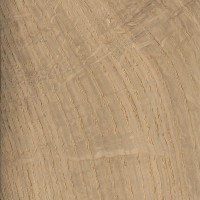 |
Common Name(s): English Oak, European Oak
Scientific Name: Quercus robur Distribution: Most of Europe, to Asia Minor, and North Africa Tree Size: 80-115 ft (24-35 m) tall, 3-5 ft (1-1.5 m) trunk diameter Average Dried Weight: 42 lbs/ft3 (675 kg/m3) Specific Gravity (Basic, 12% MC): .53, .67 Janka Hardness: 1,120 lbf (4,980 N) Modulus of Rupture: 14,100 lbf/in2 (97.1 MPa) Elastic Modulus: 1,544,000 lbf/in2 (10.60 GPa) Crushing Strength: 6,720 lbf/in2 (46.3 MPa) Shrinkage:Radial: 4.7%, Tangential: 8.4%, Volumetric: 13.0%, T/R Ratio: 1.8 |
Color/Appearance: Heartwood is a light to medium brown, commonly with an olive cast, though there can be a fair amount of variation in color. Nearly white to light brown sapwood is not always sharply demarcated from the heartwood. Quartersawn sections display prominent ray fleck patterns.
Grain/Texture: Grain is straight, with a coarse, uneven texture. May have irregular or interlocked grain depending on growing conditions of the tree.
Endgrain: Ring-porous; 2-4 rows of large, exclusively solitary earlywood pores, numerous small to very small latewood pores in radial arrangement; tyloses abundant; growth rings distinct; rays large and visible without lens; apotracheal parenchyma diffuse-in-aggregates (short lines between rays).
Rot Resistance: English Oak has been rated as having very good resistance to decay, and is commonly used in boatbuilding applications.
Workability: Produces good results with hand and machine tools. Can react with iron (particularly when wet) and cause staining and discoloration. Responds well to steam-bending. Glues, stains, and finishes well.
Odor: Has a tell-tale smell that is common to most oaks. Most find it appealing.
Allergies/Toxicity: Although severe reactions are quite uncommon, oak has been reported as a sensitizer. Usually most common reactions simply include eye and skin irritation, as well as asthma-like symptoms. See the articles Wood Allergies and Toxicity and Wood Dust Safety for more information.
Pricing/Availability: Widely grown and available in Europe, English Oak is not seen nearly as commonly in the United States, and would be considered an imported lumber. Moderately inexpensive if purchased in an area where it grows locally.
Sustainability: This wood species is not listed in the CITES Appendices, and is reported by the IUCN as being a species of least concern.
Common Uses: Cabinetry, furniture, interior trim, flooring, boatbuilding, barrels, and veneer.
Comments: English Oak falls into the white oak group, and shares many of the same traits as White Oak (Quercus alba).
One of the most famous English Oak trees, The Major Oak, is a massive tree located in Sherwood Forest, in Nottinghamshire, England. The tree is estimated to be approximately 1,000 years old, and is purported to have been a common hideout for Robin Hood and his outlaws.
- Black Oak (Quercus velutina)
- Bog Oak
- Brown Oak
- Bur Oak (Quercus macrocarpa)
- California Black Oak (Quercus kelloggii)
- Cherrybark Oak (Quercus pagoda)
- Chestnut Oak (Quercus prinus)
- Holm Oak (Quercus ilex)
- Japanese Oak (Quercus mongolica)
- Laurel Oak (Quercus laurifolia)
- Live Oak (Quercus virginiana)
- Oregon White Oak (Quercus garryana)
- Overcup Oak (Quercus lyrata)
- Pin Oak (Quercus palustris)
- Post Oak (Quercus stellata)
- Red Oak (Quercus rubra)
- Scarlet Oak (Quercus coccinea)
- Sessile Oak (Quercus petraea)
- Shumard Oak (Quercus shumardii)
- Southern Red Oak (Quercus falcata)
- Swamp Chestnut Oak (Quercus michauxii)
- Swamp White Oak (Quercus bicolor)
- Turkey Oak (Quercus cerris)
- Water Oak (Quercus nigra)
- White Oak (Quercus alba)
- Willow Oak (Quercus phellos)
Scans/Pictures: A special thanks to Steve Earis for providing the wood sample, veneer, and turned photo of this wood species.
 |
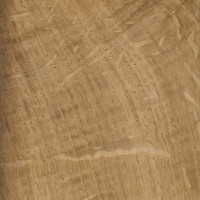 |
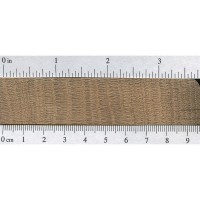 |
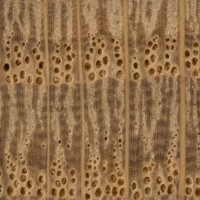 |
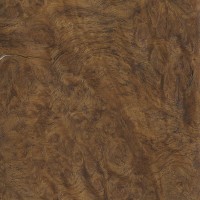 |
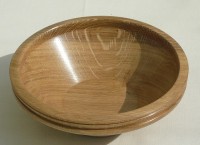 |





Has oak been use for outdoor flooring?
How do we know which solid wood can using outdoor or indoor?
Has been used by carvers for centuries. Most churches and cathedrals in Northern Europe will have something carved in Quercus spp.
One of the nicest woods to carve once you get used to the hardness.
I’ve never heard of British oak, if you have worked with British oak does it feel like it’s stronger then ash?
a good deal stronger !
British oak is apparently is harder than European oak
as far as I know its the same. They call it english oak since the begining of time, but its the same oak as in most of europe. Common oak
No its not the same, its harder by a considerable degree. In my Grandfathers on timber and elasticity, English Oak is the stongest wood available for construction.
English oak is much slower growing. Climate plays a part in this due to northerly latitude.
Much harder than French oak but french oak is more plentiful